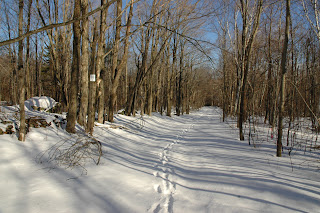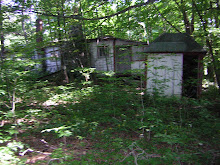Traveling north on New State Road from Adams Road, I proceeded past the discontinued Tannery and Burnett Roads, another 3/4 of a mile to Sherman Road, a handsome trail that in winter does not even attempt the pretense of being a driveable avenue. A small summer home boarded up for the season lies opposite its mouth.

 About a quarter mile down the unmaintained road lies New State Cemetery, one of the largest of 20 or so burying grounds in town, most in the process of reclamation by the forest. About 130 graves thick with the names of some of the key settling families, the same monikers seen on the roads hereabouts: Sherman, Haskins, Burnett.
About a quarter mile down the unmaintained road lies New State Cemetery, one of the largest of 20 or so burying grounds in town, most in the process of reclamation by the forest. About 130 graves thick with the names of some of the key settling families, the same monikers seen on the roads hereabouts: Sherman, Haskins, Burnett.  Sherman Road boasts many excellent stone walls, which were prominent even in a generous covering of snow. Several cellar holes can be found right along the road, square and rectangular flag stone foundations of varying sizes; more lurk farther back in the woods.
Sherman Road boasts many excellent stone walls, which were prominent even in a generous covering of snow. Several cellar holes can be found right along the road, square and rectangular flag stone foundations of varying sizes; more lurk farther back in the woods.Much of this land was at one time Shaker land, purchased by Proctor Sampson, a New Lebanon elder who came to Savoy during the mass conversion in New State to help the new followers establish their own community.
Savoy was a place of wild revivalism in the 1810s, and Shaker missionaries in the middle part of the decade found receptive ears, and a community of 80 converts grew over a five year period, controlling about 1500 acres land. These hill town shakers lived mostly in their own homes, though some of the younger members were grouped in community housing on a farm here, along with some elsewhere on the farm of James Cornell, where the sect held their meetings.

 Sherman Road becomes more winding and narrow as the ridge rises up above Gulf Brook below, the rows of wiry brown growth becoming a thicker green with younger Norway and Blue Spruce planted during the 1930s. Icy ravines criss cross underneath the road, and deer, rabbit and raccon tracks dot the surface of a brand new layer of snow in this busy wildlife corridor.
Sherman Road becomes more winding and narrow as the ridge rises up above Gulf Brook below, the rows of wiry brown growth becoming a thicker green with younger Norway and Blue Spruce planted during the 1930s. Icy ravines criss cross underneath the road, and deer, rabbit and raccon tracks dot the surface of a brand new layer of snow in this busy wildlife corridor. At about two miles in from New State Road, the "road" ends in an opening rimmed by more stone walls, where the ruins of a larger house and some smaller outlying buildings can still be clearly made out even in wintry conditions.
It is believed the group meant to create a more communal center on this land at the very end of Sherman Road. The community constructed a dam and grist mill downstream on Gulf Brook, near the mouth of "Shaker Trail" which runs southwest from the Sherman road property. Times seemed promising until drought struck in 1820 and 1821, followed by a plague of locusts, which devastated farms here and left the Savoy shakers dependent on other communities. The decision was made to relocate their numbers and resettle at communities in New Lebanon and Watervilet, New York. Most remained, but some returned to the town, and a half dozen shakers are buried in a plot a mile or so south, on the Lewis Hill Trail off Tannery Road.
The shakers continued to use some of their land here well into the mid nineteenth century for summer crops, but by the 1880s all the property had been sold back to the town. The last remaining home of one of the shaker families still stands today on Barnard Road. It is that of Nathaniel Haskins, whose son Orren went on to some fame as a shaker woodworker, whose furniture figures prominently in Shaker museums.








